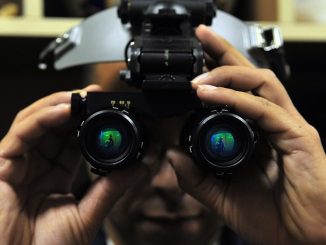
Ray Kurzweil, Google’s director of engineering and a well-known futurist revered for his accurate predictions and writing on the advance of bio-technology and the future of the human species, believes that by 2030s nanobots will inhabit our bodies to help us stay healthy. We now have one more reason to believe that the idea surrounding this prediction isn’t that far off from modern technology.
Developing nanobots that can easily move through blood and other body fluids to their targets has proven tricky but doable. It’s been much harder, though, to get these tiny bots to navigate towards hard-to-reach cavities of the human body, or dense tissues, such as those found in the eyeball, without the need for more invasive methods.
But thanks to a study published on Friday in the journal Science Advances, this is about to change. An international team of scientists has managed to develop a propeller-shaped nanometer-sized robot – approximately 200 times smaller in diameter than a human hair – that can, for the first time, drill through the interior of the eyes without damaging them.
With their shape and their slippery coating, the robot can move relatively unhindered through the dense tissue in the eye, without damaging the sensitive biological tissue around them, according to the study.
“We applied a liquid layer found on the carnivorous pitcher plant, which has a slippery surface on the peristome to catch insects,” said the study’s first author Wu Zhiguang.
“It is like the Teflon coating of a frying pan. This slippery coating is crucial for the efficient propulsion of our robots inside the eye, as it minimizes the adhesion between the biological protein network in the vitreous and the surface of our nano-robots,” added Wu.
To test their nano-propellers, the researchers injected through a small needle tens of thousands of them into a dissected pig’s eye. With the help of a surrounding magnetic field that rotates the nanopropellers and optical coherence tomography, a non-invasive imaging technique widely used in the diagnostics of eye diseases field, they were able to direct and observe the swarm to the retina at the back of the pig’s eye — just as they had hoped.
Eventually, the scientists believe this technique has the potential to be used as a minimally-invasive tool for precisely delivering drugs directly to hard to reach parts of the human body — not just the back of the eyeball.
“That is our vision,” researcher Tian Qi, one of the corresponding authors of the study said in a press release. “We want to be able to use our nanopropellers as tools in the minimally-invasive treatment of all kinds of diseases, where the problematic area is hard to reach and surrounded by dense tissue. Not too far in the future, we will be able to load them with drugs.”
The full scientific paper “A swarm of slippery micropropellers penetrates the vitreous body of the eye” can be found here.
Disclaimer: This page contains affiliate links. If you choose to make a purchase after clicking a link, we may receive a commission at no additional cost to you. Thank you for your support!




Leave a Reply